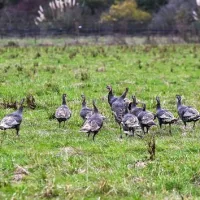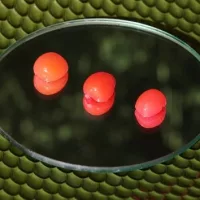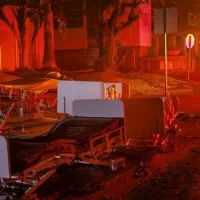
 Carolina Fenner(NEW YORK) — A 7-month-old baby girl from Florida has traveled to Russia in hopes of beginning treatments to remove a large birthmark on her face.
Carolina Fenner(NEW YORK) — A 7-month-old baby girl from Florida has traveled to Russia in hopes of beginning treatments to remove a large birthmark on her face.
Luna Fenner was born with a congenital melanocytic nevus — a skin condition appearing as an “abnormally dark, noncancerous skin patch,” according to the U.S. National Library of Medicine.
Luna’s nevus is large, making her case one of the rare occurrences, which affects one in 20,000 newborns, according to the Association for Large Nevi and Related Disorders.
Luna and her mother, Carolina Fenner, are now in Russia exploring a non-invasive surgical procedure with surgeon-oncologist Dr. Pavel Borisovich Popov.
“I decided to do the surgery especially because of the bullying,” Fenner told Good Morning America. “I started seeing people pointing at Luna on the street, asking me, ‘Is that contagious?’ It was so bad. People in this society [are] not prepared for a different [condition] like Luna has. She’s still going to have marks on her face after the surgery, [but] I’m going to teach her how to deal with people.”
Fenner said she had a healthy pregnancy, including a 4-D ultrasound, but no signs of a skin condition were picked up.
“I was in shock when I saw her and the doctor didn’t know what was [it was],” Fenner said of her daughter’s birth.
Fenner said Luna was hospitalized for six days after birth while doctors ran tests. It was concluded that she had a congenital melanocytic nevus, which was benign.
“There is no side effect. If we don’t remove it with the surgeries, with time, it will bother [her] a lot,” Fenner said. “There’s a lot of hair on top of the nevus, so I’ve been cutting the hair on her face every five, six days.”
Shailee B. Patel, MD, board-certified dermatologist and cutaneous surgeon in Miami, Fla., said giant nevi on a person’s face are uncommon because of its size and are often related to a mutation in a person’s genes.
“It is important to have the lesion classified because there is an increased risk of melanoma (skin cancer) associated with an increase in size,” Patel told GMA. “The overall risk of developing melanoma is 2-3% in giant congenital nevi.”
Fenner said she explored treatments for Luna in Chicago, Boston, New York and in her home state of Florida. Fenner and her husband Thiago wanted to pursue an option in New York, but health insurance companies would only pay for the one in Florida, Fenner said.
But it wasn’t until Dr. Popov from Russia caught wind of Luna’s story and reached out to the family, Fenner said.
“He called me and he said has some new procedure, new technology. It’s less-invasive. He sent me a few pictures of before and after. I was impressed,” Fenner recalled. “The most important part he said [was] Luna is only going to do six to eight procedures up to one-and-a-half years.”
Fenner said Luna’s first appointment with Popov is Friday. She added that using medication, Popov plans on addressing the risk of Luna’s nevus developing into cancer.
Dr. Patel said treating a nevus is important for a few reasons — one being the increased chance for developing melanoma.
“The condition also causes cosmetic disfigurement, which can have negative consequences on a person’s mental health,” Patel said. “Surgery is the best treatment but often requires multiple procedures.”
Patel added, “If surgery is not an option, physicians may use laser treatments.”
Fenner said Luna is a calm and happy baby. She and her family have been teaching Luna early on to embrace her difference — even holding a Batman-themed party to celebrate her 4-month milestone.
The Fenners have launched a GoFundMe page to raise money for the procedure, which will hopefully eliminate most of the marking on her child’s face.
“I hope people stop judging others because they have something different on their body or on their face,” Fenner said. “You should treat people with [more] respect. I’m learning this with Luna and that’s what I hope for her future.”
Copyright © 2019, ABC Radio. All rights reserved.















